
Environment
Art in Prison-A Parisian Event
International specialists meet in Paris to discuss the role of Art in Prison
Posted December 11, 2014
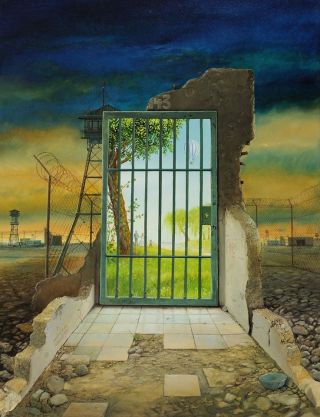
Kurt--Austria
What happens when a German prison chaplain, a British CEO of a non-profit organization, a French Sociologist and an American art therapist are brought together in Paris, France by a former banker and his wife, co-directors/producers of documentary films? You get a lively and informative discussion on the value of Art in Prison.
Background
Approximately two years ago, Bruno Lavole and Inga Lavole-Khavkina, a husband and wife filmmaking team from Paris, France approached me about a project they were working on.
Bruno worked for more than 30 years in Corporate and Investment Banking within the international network of BNPParibas, developing financing services for international corporate clients. He was posted in Hong-Kong, New York, Houston, and London and, of course, Paris. He left the bank in 2012 to create a film production company with his wife Inga. The documentary about art in prison would be their first project.
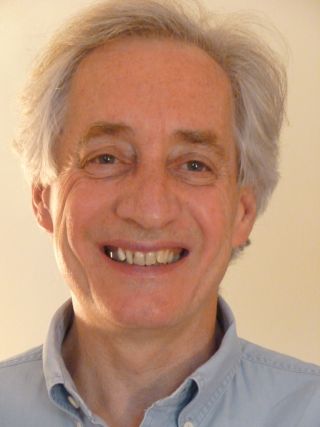
Bruno Lavole
Born and raised in Kharkov, Eastern Ukraine, Inga studied medicine and fine arts. She moved to New York in 1988 and completed her film studies at NYU. She also studied psychology for five years. She worked as the manager of the film studio at the Film and Television department at NYU film school and was also on the staff of Spielberg’s Shoah Foundation where she conducted video interviews of Holocaust survivors. She was also a founding partner of “New Post House Inc.” an independent production company, where she produced, directed, edited, filmed, a number of documentary movies.
After moving to France 9 years ago, Inga worked as creative director in a Parisian art gallery, was on the jury of the Latin American Film Festival and restarted her film career directing the prison art documentary, entitled “Half a Square Meter of Freedom”.
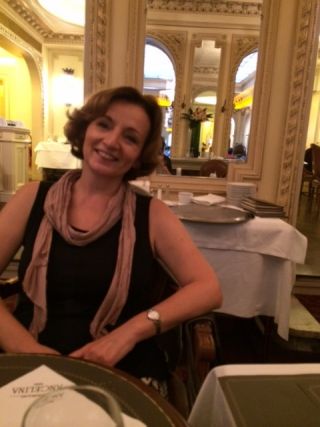
Inga Lavole-Khavkina
Bruno and Inga were in the United States to work on this documentary, and asked if they could interview me.
After kibitzing for quite some time, and filming a lengthy interview, we parted as new friends and colleagues. They suggested that if I was to ever find myself in Europe perhaps we could do an event together—I enthusiastically agreed, although I must confess, I did not know how likely that would be.
Since then, Bruno and Inga created the French not-for-profit organization with the focus to bring to Paris the collection of artwork from the prisons of more than 40 countries assembled by the program, Art and Prison e.V, in Germany, a not for profit created by Peter Echtermeyer.
So how did a banker and a filmmaker become interested in such an unusual topic?
In 2006, coming out of a church where she went to admire Caravaggio’s work in Rome, Italy, Inga stumbled upon the first international exhibition of art created in prisons curated by Peter Echtermeyer from Berlin, Germany.
After talking with Peter for some time, Inga was so moved by the work that she decided then and there to create the documentary.
Several years later, Peter created Art and Prison e.V. in Germany, in which he launched two international art contests for incarcerated men, women, and juveniles in 2009 and 2011. The collection was exhibited in 2013 in the hall of Berlin’s Ministry of Justice.
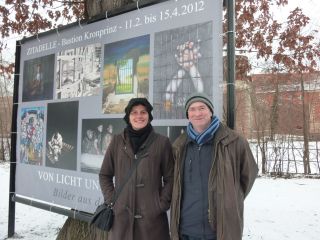
Peter Echtermeyer and Cornelia Harmel
Inga and Bruno became members of its Board to help with its international development.
They decided in late 2013 to bring this collection to Paris. After a few unsuccessful contacts, they met Dorothy Polley who made her gallery, Dorothy’s Gallery, available for just such an exhibition.
As Bruno described it, “it appeared to us that, surrounded by artwork from 40 countries where prisoners express their feelings beyond borders, different cultures, legal systems, it would be interesting to gather specialists of art in prison from different countries.” While working on their movie, they spoke with experts from various countries and “we were fortunate enough to meet people involved in art in prison from different backgrounds. Their messages complemented one another but from different angles: art therapy, sociology, religious, and different countries.”
It all comes together…
Thus, they decided to plan a month long series of events that highlighted the arts in prison with various presenters, artists and exhibitions. One of the central events was a Round Table discussion with several of these experts. These were:
- Peter Echtermeyer, the founder of Art and Prison e.V. in Berlin, curator of the show and former prison chaplain,
- Tim Robertson, CEO of the Koestler Trust, a non-profit organization known as the United Kingdom’s “best known prison arts charity” [include link here].
- Arnaud Gaillard, a sociologist from Paris who specializes in imprisonment, particularly sex offenders
- And me.
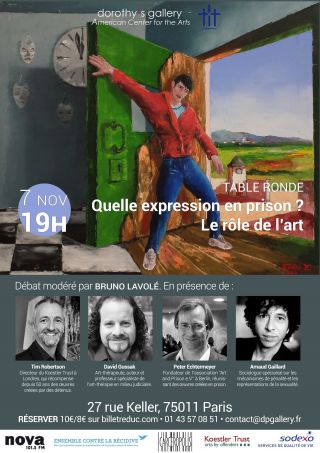
Bruno contacted me in September; he asked me if I would be available the first Friday of November to take part in a Round Table Discussion with international scholars. Given that the event was only several weeks away, I had much going on throughout September and October, I had no idea what I would talk about or what to expect, I of course, resoundingly and unhesitatingly said “sure.”
There was no doubt—it was the right decision. Funded through crowdsourcing, Bruno and Inga were able to bring everyone together with what proved to be an amazing event.
Arriving on Thursday, November 6th, 2014, the panel members had several opportunities over the next day and a half to get to know each other. Over animated discussions, great food and wine—lots of wine—a sense of camaraderie and clear awareness of our shared purpose emerged.
We were ready for Friday evening.
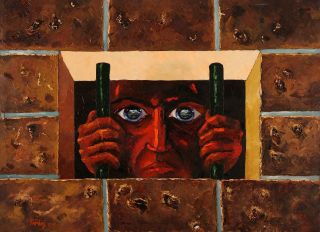
We were packed inside one of the gallery rooms with a great many artists, art patrons, enthusiastic professionals and the curious, surrounded by amazing art that adorned the walls. The five of us, along with a translator sat on folding chairs before all of the attendees—some seated, some not-- with Inga’s movie camera pointed our way. We spoke for almost 2 –and- a -half hours.
Each one of us spoke for around 15 minutes about our own perspectives about art in prison, followed by questions asked by first the moderator (Bruno) and then the audience. Despite our obvious differences, all of us essentially provided the same message.
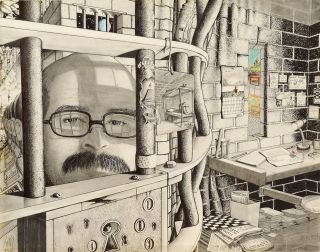
Art:
- Provides the prison inmate an opportunity to express him or herself in a safe and acceptable manner
- Can re-label the identity from that of inmate
- And can instill a sense of hope, self-value and humanity in an environment that otherwise suppresses it.
These messages were expressed with passion, intelligence and not just a little humor for almost 2 –and-a- half hours, engaging all of those who attended.
When Bruno and Inga was asked what they thought the message(s) were, they indicated that:
I felt that overall the speakers delivered a similar simple message which has two major components:
- Whatever someone has done, he is a human being and deserves to be treated as one
- Art can facilitate the future re-integration of prisoners within society upon their release.
Bruno added, “I did not feel major differences beyond that. Arnaud as a sociologist was more interrogating with the notion of imprisonment itself, Peter expressed more sensitivity to the spiritual element contained in art, but I felt that those were more nuances than differences.
Even after we finished speaking, many of the attendees milled about to ask us questions and provide us their perspective. Despite obvious language barriers, we all found a way to communicate about how important the art was for this population.
We did not want it to end.
In this spirit, I asked Bruno, “what's next?”
He did not hesitate. Although still in the middle of the month long series of events in Paris, he is already looking ahead.
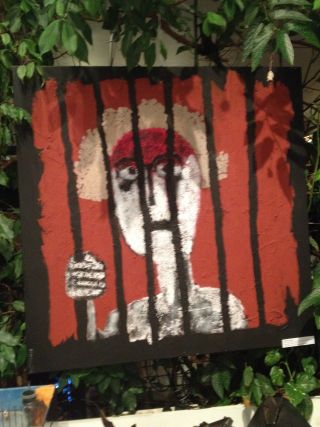
He intends to:
- start an international not-for-profit organization, building on what exists and develop it further
- include prison administrations in our initiatives
- bring this exhibition to other countries, including the US
- present this exhibition in prisons
- organize another exhibition and series of events including the international roundtable in other countries, and, building on this first experience, give it more exposure
- look for stable and sufficient financing for these initiatives
Of course, we mustn’t forget the film project—remember the film? Bruno and Inga will integrate the footage of the exhibit, events and the Discussion into their footage, and they hope to eventually film art workshops in prisons. Once finished, they hope to, amongst other venues, screen it in prisons.
Please go to this link to see a clip from this film about this wonderful experience.
From a personal perspective, this was an awe-inspiring event, and I truly believe that this was the beginning of much more to come.



